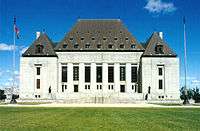Tsilhqot'in Nation v British Columbia
| Tsilhqot'in Nation v British Columbia | |
|---|---|
|
| |
| Hearing: 7 November 2013 Judgment: 26 June 2014 | |
| Citations | 2014 SCC 44 |
| Docket No. | 34986 |
| Prior history | Appealed from British Columbia |
| Ruling | Appeal allowed |
| Court Membership | |
|
Chief Justice: Beverley McLachlin Puisne Justices: Louis LeBel, Rosalie Abella, Marshall Rothstein, Thomas Cromwell, Michael Moldaver, Andromache Karakatsanis, Richard Wagner | |
| Reasons given | |
| Unanimous reasons by | McLachlin CJ |
Tsilhqot'in Nation v British Columbia 2014 SCC 44 is a landmark decision of the Supreme Court of Canada which established Aboriginal land title for the Tsilhqot'in First Nation, with larger effects. As a result of the landmark decision, provinces cannot claim a right to engage in clear-cut logging on lands protected by Aboriginal title; they must gain approval for such action from the title-holder before proceeding.[1]
Background
In 1983, the province of British Columbia issued a licence to Carrier Lumber to cut trees in lands that included remote central British Columbia territory which was claimed by the Xeni Gwet'in band of the Tsilhqot'in. The Tsilhqot'in are a semi-nomadic group of First Nations people who had lived in the area for centuries, managing these lands and repelling invaders. The Xeni Gwet'in blockaded the area, preventing Carrier from logging. The company conducted unsuccessful negotiations with the provincial government to continue logging.[2] The Xeni Gwet'in filed suit seeking a court declaration that would prohibit Carrier Lumber's commercial logging operations in this area, and establish their claim for Aboriginal title to the land, which was part of their historic territory.
The courts below
At trial, which lasted five years, both the federal and provincial governments opposed the title claim. The trial judge applied a test for Aboriginal title that examined whether the Xeni Gwet'in regularly and exclusively used the sites or territory within the claim area. The trial judge rejected the title claim for procedural reasons.
In 2012, the decision was appealed to the British Columbia Court of Appeal, where the court upheld the decision that the Tsilhqot'in did not hold title to these lands, except for limited situations.[3] The court applied a more stringent title test that examined site-specific occupation of definite tracts of land at the time of European sovereignty.
Decision of the Supreme Court
The Supreme Court, led by McLachlin CJ, unanimously allowed the appeal. They ruled that the Tsilhqot'in did have a claim of Aboriginal title to the 1,750 square kilometres (680 sq mi) region they had historically occupied.
Aboriginal title
The court held that Aboriginal title constitutes a beneficial interest in the land, the underlying control of which is retained by the Crown.[4] Rights conferred by Aboriginal title include the right to decide how the land will be used; to enjoy, occupy and possess the land; and to proactively use and manage the land, including its natural resources.[5] But, the court set out a Sparrow-style mechanism by which the Crown can override Aboriginal title in the public interest:
- the Crown must have carried out consultation and accommodation;
- the Crown's actions must have been supported by a compelling and substantial objective; and
- the Crown's action must have been consistent with its fiduciary obligation to the Aboriginal body in question.[6]
Effects
As a result of the landmark decision, provinces cannot claim a right to engage in clear-cut logging on lands protected by Aboriginal title and must gain approval for such action from the title-holder before proceeding.[1]
